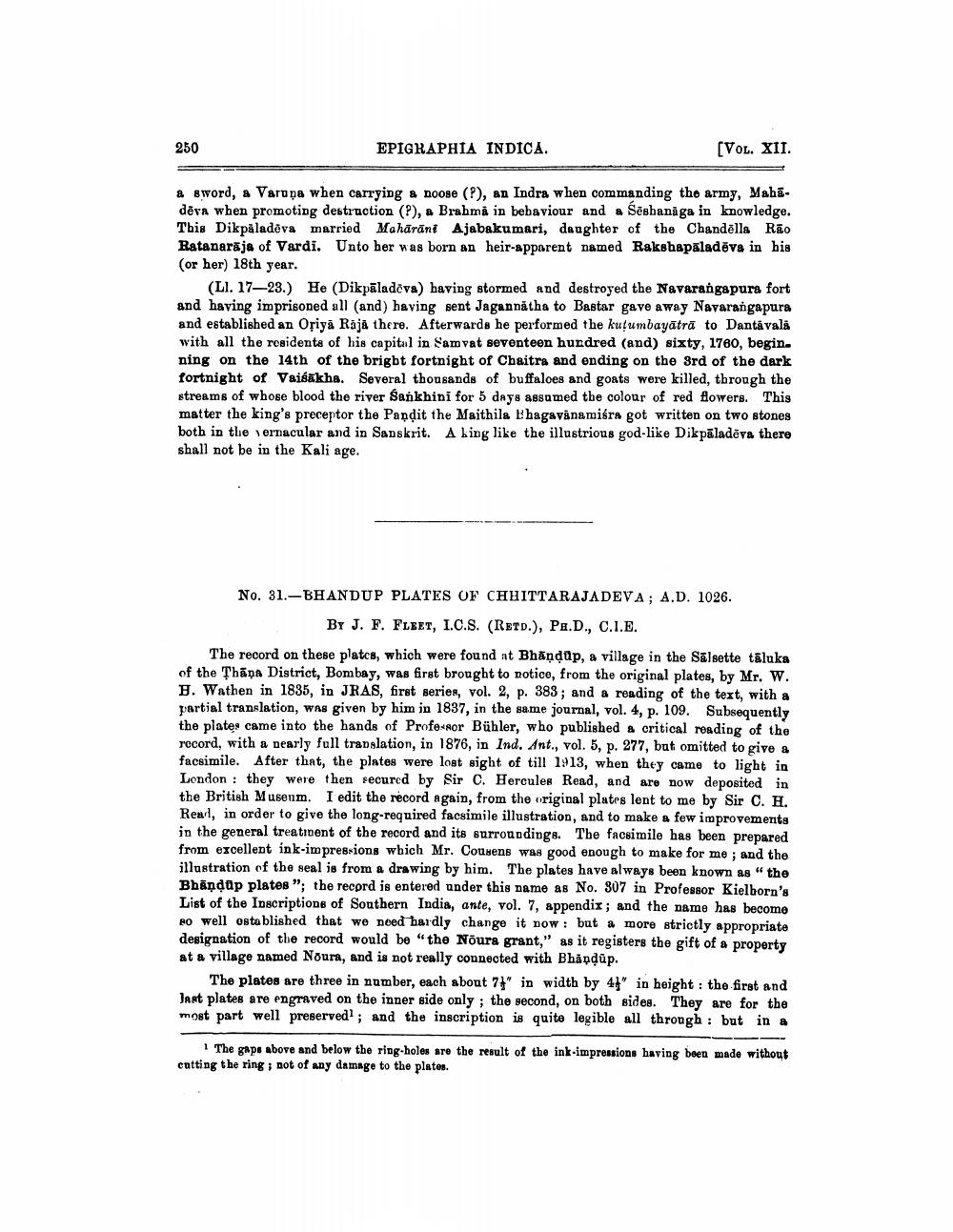________________
250
EPIGRAPHIA INDICA.
(VOL. XII.
a sword, a Varupa when carrying & noose (?), an Indra when commanding the army, Mahadēva when promoting destruction (P), a Brahmå in bebaviour and a Sēsbanāga in knowledge. This Dikpåladeva married Mahārāni Ajabakumari, daughter of the Chandēlla Rao Ratanaraja of Vardi. Unto her was born an heir-apparent named Rakshapaladēva in his (or her) 18th year.
(LI. 17-23.) He (Dikpāladova) having stormed and destroyed the Navarangapura fort and having imprisoned all (and) having sent Jagannatha to Bastar gave away Navarangapura and established an Oriya Raja there. Afterwards he performed the kutumbayātrā to Dantávala with all the residents of his capital in Samvat seventeen hundred (and) sixty, 1760, begin. ning on the 14th of the bright fortnight of Chaitra and ending on the 3rd of the dark fortnight of Vaisakha. Several thousands of buffaloes and goats were killed, through the streams of whose blood the river Sankhini for 5 days assumed the colour of red flowers. This matter the king's preceptor the Pandit the Maithila hagavinamióra got written on two stones both in the vernacular and in Sanskrit. A king like the illustrious god-like Dikpāladēva there shall not be in the Kali age.
No. 31.-BHANDUP PLATES OF CHHITTARAJADEVA; A.D. 1026.
BY J. F. FLEET, I.C.S. (Retd.), Pa.D., C.I.E. The record on these plates, which were found at Bhandup, a village in the Salsette täluka of the Thāna District, Bombay, was first brought to potice, from the original plates, by Mr. W. 1. Wathen in 1835, in JRAS, first series, vol. 2, p. 383; and a reading of the text, with a partial translation, was given by him in 1837, in the same journal, vol. 4, p. 109. Subsequently the plates came into the hands of Profesor Bühler, who published a critical reading of the record, with a nearly full translation, in 1876, in Ind. Ant., vol. 5, p. 277, but omitted to give a facsimile. After that, the plates were lost sight of till 1913, when they came to light in London : they were then secured by Sir C. Hercules Read, and are now deposited in the British Museum. I edit the record again, from the original plates lent to me by Sir C. H. Real, in order to give the long-required facsimile illustration, and to make a few improvements in the general treatment of the record and its surroundings. The facsimile has been prepared from excellent ink-impressions which Mr. Couens was good enough to make for me, and the illustration of the seal is from a drawing by him. The plates have always been known as "the Bhandap plates"; the record is entered under this name as No. 807 in Professor Kielborn's List of the Inscriptions of Southern India, ante, vol. 7, appendix ; and the name has become 80 well established that we need hardly change it now: but a more strictly appropriate designation of the record would be "the Nõura grant," as it registers the gift of a property at a village named Noura, and is not really connected with Bhandup.
The plates are three in number, each about 71" in width by 41" in height: the first and Jast plates are engraved on the inner side only; the second, on both sides. They are for the most part well preserved?; and the inscription is quite legible all through : but in a
1 The gaps above and below the ring-holes are the result of the ink-impressions having been made without cutting the ring ; not of any damage to the plates.




